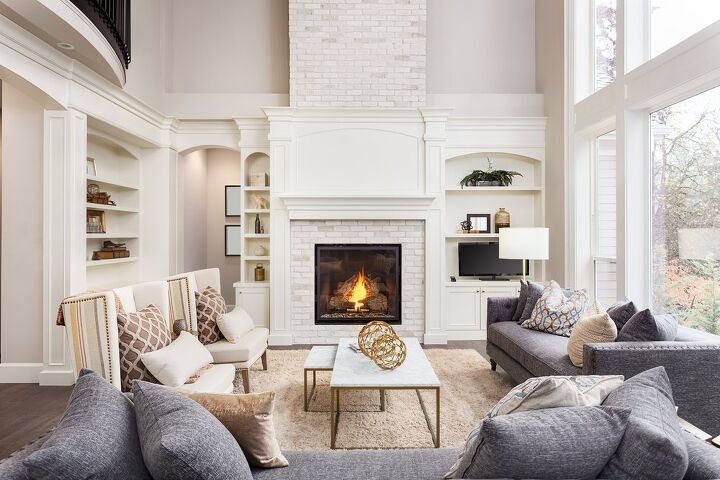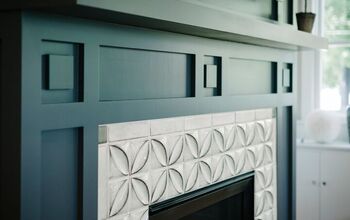What Is A Prefabricated Fireplace?
Are you considering installing a fireplace in your home? It’s easy to understand why fireplaces are so popular, especially in colder climates. This feature adds charm, warmth, and a homier feel to any living space. Not to mention, a well-installed fireplace can up your home’s resale value.
Picking the right style of fireplace can be a tough choice. You’re probably familiar with traditional masonry fireplaces, but what is a prefabricated fireplace?
Prefabricated fireplaces – also referred to as factory-built fireplaces – are manufactured off-site in a factory. Prefab fireplaces include a firebox, chimney, and chimney cap. These complete systems are safety tested by the manufacturer before installation. Prefabricated fireplaces are common in newer homes for their affordability, modern appearance, and wood-burning or gas model options.
Do You Need Fireplace Installation Services?
Get free, zero-commitment quotes from pro contractors near you.

What is a Prefabricated Fireplace?
A prefabricated fireplace is an affordable, contemporary fireplace option for newer homes. Is your home newer and not designed for a masonry fireplace? If you don’t want to deal with a pricey construction project, consider a factory-built fireplace.
Prefab fireplaces are made of solid metal sheets, and are purchased as a complete system. This system is safety tested by the manufacturer, and includes:
- A metal firebox. The firebox interior is made of solid metal sheets, and sometimes refractory panels made to look like bricks. These refractory panels help insulate the firebox and protect it from the heat.
- A metal chimney and chimney siding. The metal chimney runs from the firebox up through the roof. A siding or simulated brick can house the chimney, making it look more visually appealing.
- A firestop. The firestop is a form of fire protection. It seals the joints and openings within a floor or wall.
- A chimney flashing and chimney cap. These components attach to the exterior of the chimney, protecting them from the elements.
Prefab fireplaces come in a wood-burning, a gas, or a combined model. They are versatile, installable in various living spaces. The key is to ensure the firebox and chimney extending through the roof are installed properly. Poor installation can result in house fires.
A prefab fireplace is highly insulated and energy-efficient. This means it can be installed fairly close to combustible materials. You can also customize the surrounds by adding molding, a mantel, stonework, etc. So while the firebox customizable, you can design the nearby walls.
Types of Prefabricated Fireplaces
All prefabricated fireplaces share similar characteristics. They consist of well-insulated fireboxes with interior solid metal sheets. The interior is sometimes lined with refractory panels. Factories build and safety test them off-site. Then professionals install them in your home as a complete system.
The main differences between prefab types have to do with the fuel used to produce the heat. Read on to learn more about the two primary prefabricated fireplace models.
Prefab Wood-Burning Fireplace
Prefabricated wood-burning fireplaces use burning wood logs as fuel. These models require a wood supply and storage space for the wood. They are also pricier than prefab gas fireplaces, as they require an additional venting unit. And the cleaning gets messier than with gas fireplaces.
The benefits of wood-burning fireplaces are numerous. They are as close to traditional masonry fireplaces as you can get. They provide a cozy, crackling fire and its smoky smells. You will feel comforted in your living space all winter long.
Prefab Gas Fireplace
Prefabricated gas fireplaces use natural gas or propane as the fuel source. This model of prefab doesn’t require an extra vent like wood burning. The gas moves through a simple gas line near the fireplace. Homeowners can control the gas and heat intensity using an automatic switch.
Prefab gas fireplace interiors can sport a tile or fake log design. The firebox is a bit cheaper than a prefab wood burning fireplace, and requires far less cleaning. If you don’t mind gas appliances in your home, this is a great choice.
Prefabricated Fireplaces vs. Masonry Fireplaces
Most people are familiar with the traditional masonry fireplace. These are elegant, handcrafted, one-of-a-kind fixtures in a home. But prefabricated fireplaces are rising in popularity for newer homes. They are affordable and quick to install. Discover the main differences between a prefabricated and masonry fireplace.
Masonry Fireplace
Traditional masonry fireplaces are what most people picture when they think of a fireplace. Masons build these fireplaces on-site during the house construction. The fireplace interior is made of brick or stone, as well as the chimney. The doors can come in an inside mount style or overlap mount style.
Many homeowners love masonry fireplaces because they are works of art. They are built on-site, and built to last a lifetime when properly maintained. They do require diligent cleaning to avoid creosote buildup. In addition, you should regularly coat them with water repellent to avoid crumbling.
Prefabricated Fireplace
A prefabricated fireplace installation is far cheaper than a masonry fireplace construction. That’s because altering the foundation of your home will not necessary. Prefab fireplaces are appliances, so their components eventually wear out. A well-maintained prefab fireplace lasts 20-30 years, while masonry should last a lifetime.
Fortunately, the metal flues of prefabs are much easier to clean than masonry interiors. They are less likely to develop creosote buildup. Their ease of installation means they can go in a variety of spaces. They also come in a gas model, which avoids dealing with wood supply and cleanup.
Do You Need Fireplace Installation Services?
Get free, zero-commitment quotes from pro contractors near you.

Related Questions
How long does a prefabricated fireplace last?
Prefabricated fireplaces, like other major appliances, should last between 20-30 years. But some continue to function for upwards of 40 years. Consider replacing your prefab fireplace around the 30-year mark. After that, the risk of a house fire greatly increases.
Are prefabricated fireplaces safe?
Prefabricated fireplace manufacturers thoroughly safety-test them once built. The important thing is to ensure proper installation of prefabs in your home. In addition, any replacement parts must match the specific fireplace you own. Get your fireplace inspected once it reaches 20-30 years of use.
Related Guides
More by Jessica Vaillancourt















![How To Reset A Whirlpool Cabrio Washer [In 5 Easy Steps!]](https://cdn-fastly.upgradedhome.com/media/2023/07/31/9076531/how-to-reset-a-whirlpool-cabrio-washer-in-5-easy-steps.jpg?size=350x220)











